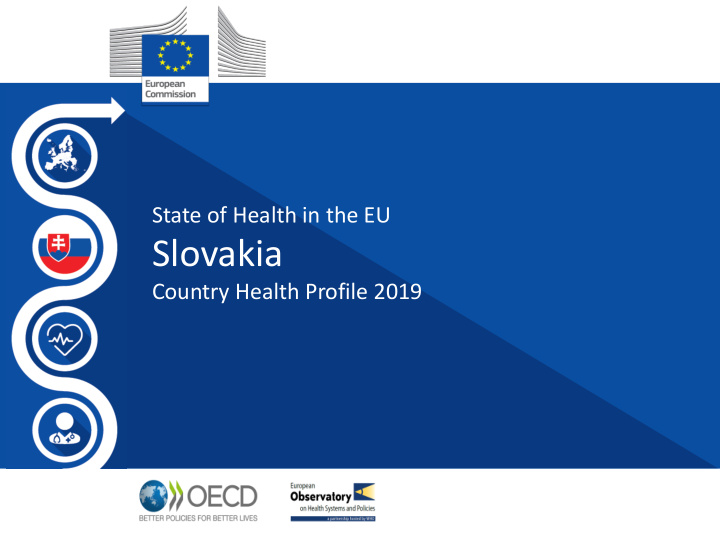



State of Health in the EU Slovakia Country Health Profile 2019
Country Health Profile
Health in Slovakia
Life expectancy has increased substantially but remains among the lowest in the EU • Between 2000 and 2017, LE increased more than in the EU as a whole • Gap in LE by gender and education is higher than the EU average
Cardiovascular diseases are the leading cause of death in Slovakia One in four deaths in 2016 were due to IHD (4 th highest rate in the EU) • • Mortality from cancer was the third highest in the EU in 2016
Slovaks live longer lives but do not necessarily age in good health • Three quarters of the life after 65 is spent with some health issues and disabilities • More than 40% of people aged 65 and above report at least one chronic condition (less than the EU average)
Risk Factors
Tobacco consumption and excessive drinking constitute major public health issues in Slovakia
Tobacco consumption and excessive drinking constitute major public health issues in Slovakia • Tobacco consumption is high in Slovakia: • 1/5 adults smoked daily in 2014, above the EU average • The prevalence of daily smoking has not decreased in recent years • Heavy episodic alcohol consumption in adolescents presents a growing challenge • Obesity rates are lower than in the EU as a whole Behavioral risk factors account for half of all deaths
Health system in Slovakia
Spending on heath has increased but remains much below the EU average • Spending on health per capita accounted in 2017 for EUR 1 600 (40% of the EU average), representing 6.7% of GDP • But more than 80% of current health expenditure are publically funded
Pharmaceuticals represent the largest cost-item • Spending on pharmaceuticals represented more than one-third of the total health expenditure (18% in the EU) • Spending on prevention is the lowest in the EU in absolut terms (adjusted for PPP)
The number of nurses is well below the EU average • Slovakia is one of the few countries reporting a reduction in the number of nurses between 2000 and 2017
Effectiveness of the health system
A substantial proportion of deaths could be avoided • Slovakia has among the highest mortality rates from preventable and treatable causes • 11 000 deaths could have been avoided through better prevention • 8000 through more adequate and timely health interventions
Vaccination rates are high in children but insufficient among adults
Too little priority is being given to prevention • Only 1% of current health expenditure is being allocated to prevention • Concrete prevention actions to tackle tobacco consumption and alcohol consumption have been limited • The adoption of the 2018 national cancer plan is an important step forward: • Screening rates are lower than in the EU as a whole • 5-years survival as well • Slovakia was one of the last EU countries without a national strategy to address cancer
Accessibility of the health system
Slovak people report low levels of unmet medical needs • Only 2.4% of the population reported unmet medical needs in 2017 • But the situation varies a lot depending on the income group, place of living or ethnicity
Marginalized communities face barriers to accessing care and report poorer health indicators
Repartition of healthcare providers varies substantially from one region to another • Ageing and outmigration of the healthcare workforce poses threats to population access • Recent initiatives have been taken to improve retention and training capacities
The level of OOP is close to the EU average • Pharmaceuticals are the main driver of OOPs (more than 40% of the total)
Resilience
Slovakia has room to improve healthcare at limited costs • Population ageing will put pressure on health and long-term care expenditure • The “Value for Money” project helped to identify efficiency gains
Reforming the hospital sector can lead to outcomes • Despite recent reductions in the number of beds, the Slovak health system remains very hospital-centric • Introducing DRGs can contribute to improve speding efficiency • A revision of the structure of the hospital network is underway
Other sectors could contribute to improve efficiency • PHC is being strengthened • The role and responsibilities of GPs are being increased • Training of GPs is being revised • Better control of pharmaceutical expenditure: • International collaborations • Centralized procurement • Revision of pricing policies • INN prescribing
Main messages
Main messages Health of the population has improved in recent years but remain Health among the lowest in the EU. Substantial disparities persist across gender, social and ethnic groups. Preventable and treatable mortality are among the highest in the EU. Quality The limited focus on prevention is a major concern and the country lacks of a system-wide approach on this issue. Access is generally good but some marginalized populations face important difficulties. The level of OOPs is close to the EU and mainly Access driven by pharmaceuticals. The availability and repartition of healthcare professionals is an important issue. Population ageing will put significant pressure on health and LTC expenditure. Important efficiency gains can still be reaped: more focus Resilience on PHC and prevention, reform of the hospital sector, control of pharmaceutical expenditure.
ec.europa.eu/health/state oecd.org/health/health-systems/country-health-profiles-EU.htm euro.who.int/en/about-us/partners/observatory/publications/country-health-profiles
Recommend
More recommend